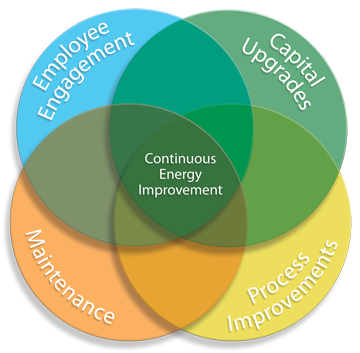Energy Improvement Brings Efficiency to Next Level
At most facilities, everyone consumes energy but only a few are accountable for the costs incurred. Continuous Energy Improvement (CEI) is a new model in energy efficiency which assures, in effect, that energy efficiency and conservation become an integral part of the business culture, and that controlling energy costs is important to everyone. The CEI model goes far beyond capital upgrades — which have traditionally been the major driver of business energy efficiency initiatives — and applies innovative strategies to achieve process improvements, update maintenance cycles, and increase employee engagement. This holistic, long-term, and data-driven approach enables businesses to fully understand how they use energy, and to also generate an actionable "roadmap" for effectively managing this critical component of their production costs against a variable landscape.
Key Recommendations
- Analyze energy consumed at every stage in the production process
- Use data to set long-term energy goals
- Create a culture of engagement among employees
- Continually seek opportunities to achieve your energy goals
Measuring and Evaluating Energy Costs in a Variable Environment
Many organizations strive for continuous improvement across the full range of their operations, including safety, productivity, and quality. Similarly, many businesses are taking strong steps to integrate data as a key driver in setting strategic goals and informing tactical decisions. These efforts are influenced by increasingly complex and rapidly changing business conditions which necessitate that we all access and analyze a profusion of information, every day, to achieve success and thrive. In other words, no intelligent decision can be made in a vacuum – and every choice must be subject to regular re-evaluation, with an eye towards constant improvement.

The four components of a Continuous Energy Improvement approach can be applied by any business to take control of energy costs. A common — and faulty — assumption is that it is not possible to control expenses related to energy. This is simply not the case. Energy, like economics, can be divided into two parts: the supply side and the demand side. The demand side is where all businesses can make a difference through thoughtful implementation of energy efficiency technologies and by adjusting their approach, philosophy, and processes to promote energy conservation.
That being said, you cannot manage something you are not measuring. With the price of metering equipment having declined over the past few years, most processes can be monitored at a relatively low cost. A truly effective measurement and management approach requires establishing performance targets, monitoring current status, sharing results with management and staff, and continually taking action across the organization to improve performance over time. Recently, many tools have begun emerging in the marketplace to empower companies to bring this level of energy management and accountability to tracking, understanding, and controlling energy consumption and costs. At Efficiency Vermont, we are one of several leading edge utilities and energy efficiency organizations that have worked to support the adoption of these tools among our customers. The results from program participants have been very positive with demonstrated success in implementing and realizing cost-effective savings from Continuous Energy Improvement (CEI).